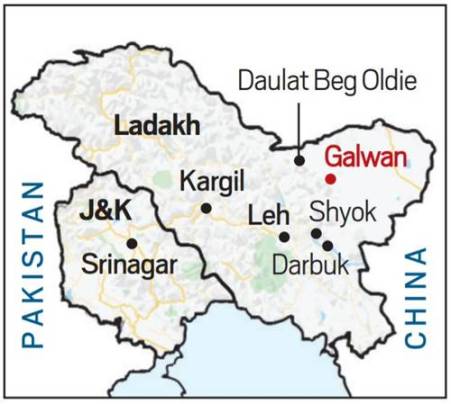- India
- International
Why Ladakh matters to India, China: history, geography, and strategy
What is it about this cold, dry, high altitude territory with its extremely scarce vegetation that makes it a point of disagreement between India and China?
 The importance of Ladakh to both India and China is rooted in complicated historical processes that led to the territory becoming part of the state of Jammu and Kashmir. (AP Photo)
The importance of Ladakh to both India and China is rooted in complicated historical processes that led to the territory becoming part of the state of Jammu and Kashmir. (AP Photo)
In July 1958, an official monthly magazine in China named China pictorial published a map of the country that would in the next few months become a bone of contention between India and its East Asian neighbour. The map in question showed large parts of the North East Frontier Agency (NEFA) and the Himalayan territory of Ladakh as part of China.
The publication had been preceded with the Chinese building a road linking parts of Ladakh with Xinjiang, an autonomous region in China, and Tibet, which was by then under Chinese control. Soon after ‘China pictorial’ came out with the new Chinese map, the leaders of both countries began writing to each other frequently regarding Ladakh.
The exchange of letters between Jawaharlal Nehru and his Chinese Premier Zhou Enlai was followed by the Sino-Indian war of 1962. The war also led to the formation of the loosely demarcated Line of Actual Control (LAC) running through Ladakh.
On Monday as fighting broke out along the disputed border between the Indian and Chinese militaries, at least 20 Indian soldiers including a commanding officer lost their lives.
What is it about this cold, dry, high altitude territory with its extremely scarce vegetation that makes it a point of disagreement between India and China? In his statement in the Lok Sabha in August 1959, Nehru had said: “There is a large area in eastern and north-eastern Ladakh which is practically uninhabited.” “Where not even a blade of grass grows,” he had said famously.

Political scientists Margaret W. Fisher and Leo E. Rose writing in their 1962 paper, ‘Ladakh and the Sino-Indian border crisis’ noted that “indeed it is open to question how many persons in the western world could then have located Ladakh with any precision, or even perhaps have stated with any confidence the nationality of the Ladikhis.”
“Certainly very few would have credited a prediction that armed clashes and the threat of full-scale war between India and China would arise over possession of the high alkaline plain known as Aksai Chin,” they said.
 An army convoy move along a Srinagar- Leh highway leading to ladakh, at kashmir’s Ganderbal district. (Express photo by Shuaib Masoodi)
An army convoy move along a Srinagar- Leh highway leading to ladakh, at kashmir’s Ganderbal district. (Express photo by Shuaib Masoodi)
The importance of Ladakh to both India and China is rooted in complicated historical processes that led to the territory becoming part of the state of Jammu and Kashmir, and China’s interest in it post the occupation of Tibet in 1950.
The integration of Ladakh into Jammu and Kashmir
Up until the Dogra invasion of 1834, Ladakh was an independent Himalayan state, much the same way as Bhutan and Sikkim. Historically and culturally, however, the state was intrinsically linked to neighbouring Tibet. Language and religion linked Ladakh and Tibet; politically too, they shared a common history.
“Ladakh was part of the Tibetan empire which broke up after the assassination of King Langdarma in 742 CE,” historian John Bray wrote in his research paper, ‘Ladakhi history and Indian nationhood.’ “Thereafter it became an independent kingdom, though its borders fluctuated at different periods of its history and, at times included much of what is now western Tibet.”
Economically, the importance of the region stemmed from the fact that it was an entrepôt between central Asia and Kashmir. “Tibetan pashm shawl wool was carried through Ladakh to Kashmir. At the same time, there was a flourishing trade route across the Karakorum pass to Yarkand and Kashgar to Chinese Turkestan,” Bray wrote.
As the Sikhs acquired Kashmir in 1819, Emperor Ranjit Singh turned his ambition towards Ladakh. But it was Gulab Singh, the Dogra feudatory of the Sikhs in Jammu, who went ahead with the task of integrating Ladakh into Jammu and Kashmir.
The British East India Company, which was by now steadily establishing itself in India, had lacked interest in Ladakh initially. However, it did show enthusiasm for the Dogra invasion of the area, with the hope that as a consequence, a large portion of Tibetan trade would be diverted to its holdings.
In 1834, Gulab Singh sent his ablest general, Zarowar Singh Kahluria, with 4,000 infantrymen to conquer the territory.
“There was no opposition at first, as the Ladakhis were taken by surprise, but on August 16, 1834, the Dogras defeated an army of some 5,000 men under the Bhotia leader, Mangal, at Sanku,” historian Robert A. Huttenback wrote in his article, ‘Gulab Singh and the creation of the Dogra state of Jammu, Kashmir and Ladakh.’ Thereafter, Ladakh came under Dogra rule.
In May 1841, Tibet under the Qing dynasty of China invaded Ladakh with the hope of adding it to the imperial Chinese dominions, leading to the Sino-Sikh war. However, the Sino-Tibetan army was defeated, and the Treaty of Chushul was signed that agreed on no further transgressions or interference in the other country’s frontiers.
 Historically and culturally, Ladakh was intrinsically linked to neighbouring Tibet. Language and religion linked Ladakh and Tibet; politically too, they shared a common history. (Express Photo)
Historically and culturally, Ladakh was intrinsically linked to neighbouring Tibet. Language and religion linked Ladakh and Tibet; politically too, they shared a common history. (Express Photo)
After the first Anglo-Sikh war of 1845-46, the state of Jammu and Kashmir, including Ladakh, was taken out of the Sikh empire and brought under British suzerainty.
“The state of Jammu and Kashmir was essentially a British creation, formed as a buffer zone where they could meet the Russians. Consequently, there was an attempt to delimiting what exactly was Ladakh and the extent of the state of Jammu and Kashmir, but it became convoluted since that area came under Tibetan and Central Asian influence,” researcher and international security analyst Abhijnan Rej told The Indian Express in a telephonic conversation.
“It is important to remember though, at that time people did not have a very good sense of which country they belonged to. So one can argue that when the mapping happened defining the state of Jammu and Kashmir, the British may have overstepped,” Rej added.
The British legacy of the map of the territory though continued to remain the ground upon which India laid its claim on the area. In his book India after Gandhi, historian Ramachandra Guha wrote that “the Indians insisted that the border was, for most part, recognised and assured by treaty and tradition; the Chinese argued it had never really been delimited. The claims of both governments rested in part on the legacy of imperialism; British imperialism (for India), and Chinese imperialism (over Tibet) for China.”
Chinese interest in Ladakh after the occupation of Tibet in 1950
The annexation of Tibet by the People’s Republic of China in 1950 sparked newfound interest in Ladakh, and particularly so after the 1959 Tibetan uprising that erupted in Lhasa when the Dalai Lama fled into exile and was granted political asylum in India.
“In attempting to crush the Tibetan revolt while at the same time denying its existence, the Chinese have used methods which have brought China and India into sharp conflict,” Fisher and Rose wrote.
To begin with, the road that the Chinese built across Ladakh in 1956-57 was important for the maintenance of their control over Tibet. “Without such a supply route, the at the time unacknowledged Khampa revolt in eastern Tibet might have reached dangerous proportions,” they noted. “Indeed, in the event of any serious weakening of the Peking government, this area might well prove to be the key to Chinese hold over Tibet.”
The building of the road through Ladakh upset Nehru’s government.

“Nehru had hoped that Tibet would have a degree of autonomy even though it came under Chinese occupation. A relatively independent Tibet would serve as a buffer between the Chinese and India,” Rej said. “Once the road construction started, he knew that the original Chinese territory which is Xinjiang will have a direct connection with Tibet. This meant that the Chinese could keep on exercising their control,” he added.
The diplomatic negotiations failed, and the war of 1962 followed.
On why conflict has flared up again in Ladakh, Rej said: “There are two layers to this. First, up to 2013 India’s infrastructural development in that area was minimal. From 2013, India started pushing for infrastructure projects there and by 2015, it became a major defence priority.
“The second layer is the August 5, 2019 decision (to remove the special status of Jammu and Kashmir and downgrade the state into two Union Territories). From the Chinese point of view, they would have assumed that if India makes Ladakh a Union Territory, they would be reasserting its control over the entire state. Moreover, it is also important to note that over time, Xinjiang which is part of Aksai Chin, has become very important to China for their internal reasons,” he added.
More Explained
EXPRESS OPINION
Apr 25: Latest News
- 01
- 02
- 03
- 04
- 05










































